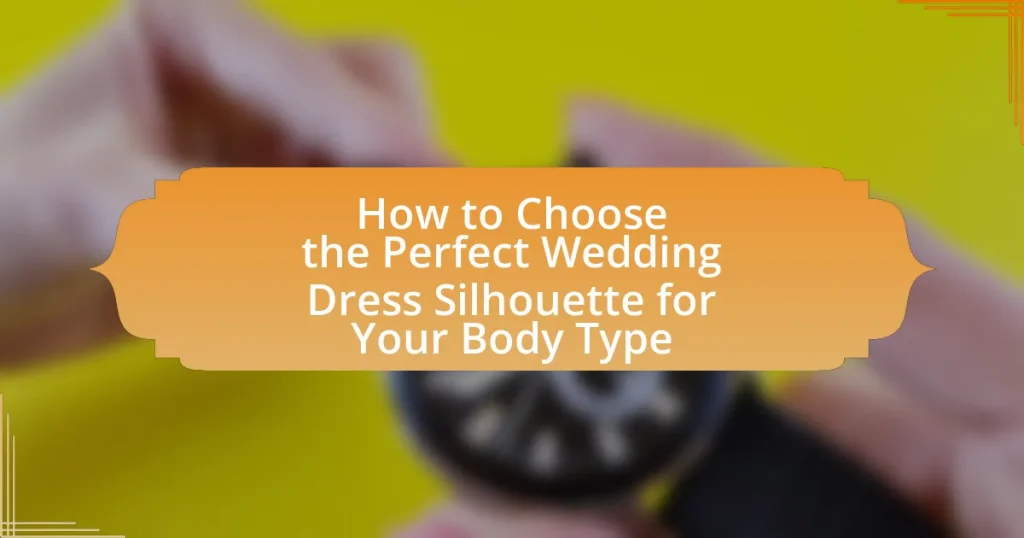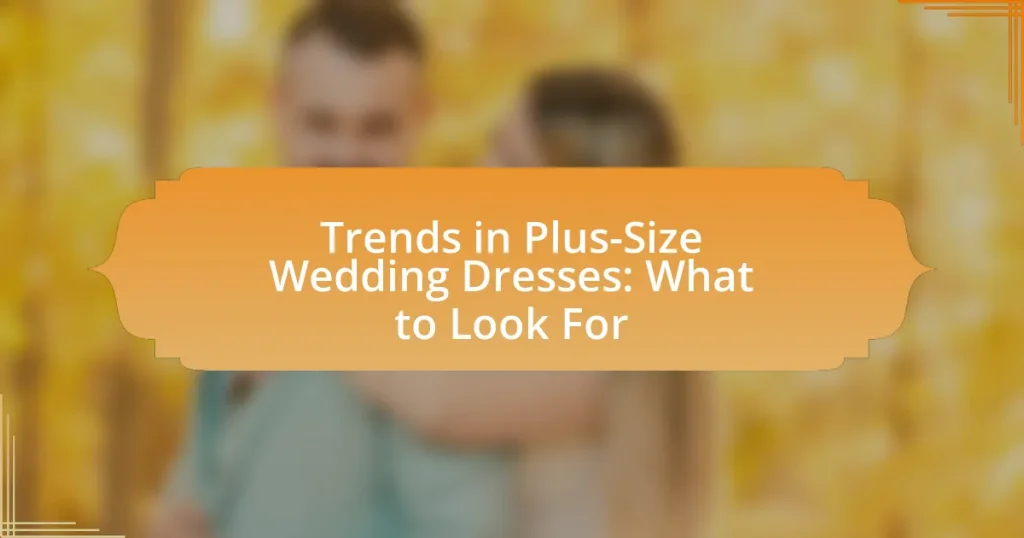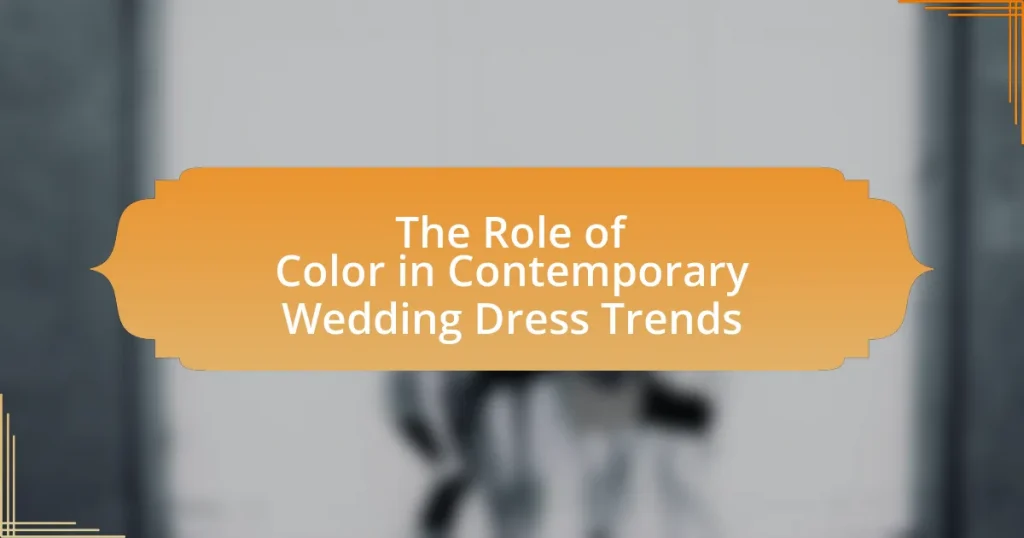The article focuses on how to choose the perfect wedding dress silhouette based on individual body types. It outlines the importance of considering factors such as body shape, personal style, and wedding theme when selecting a silhouette. Key body types, including hourglass, pear, apple, and rectangular, are discussed alongside their corresponding flattering silhouettes like A-line, ball gown, mermaid, and sheath. The article also emphasizes the significance of comfort and venue appropriateness in making the final decision, providing practical tips for effective communication with bridal consultants and avoiding common mistakes during the selection process.
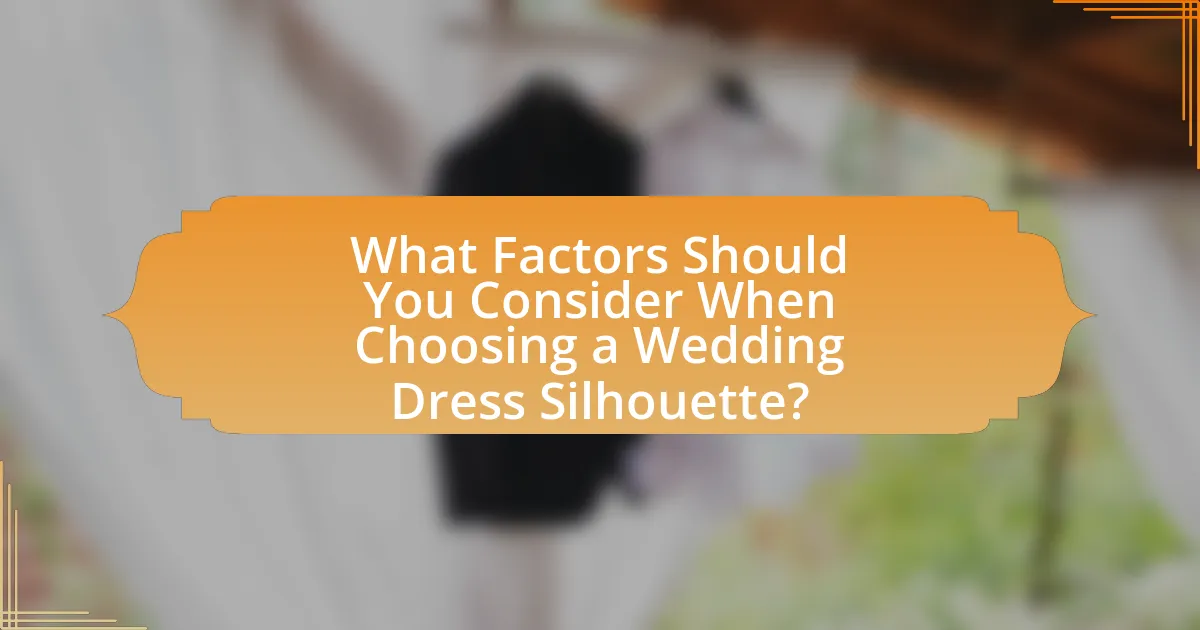
What Factors Should You Consider When Choosing a Wedding Dress Silhouette?
When choosing a wedding dress silhouette, consider your body type, personal style, and the wedding theme. Body type influences how different silhouettes will fit and flatter your shape; for example, A-line dresses suit most figures, while mermaid styles accentuate curves. Personal style reflects your preferences, whether you prefer classic, modern, or bohemian looks, which can guide your silhouette choice. Additionally, the wedding theme, such as formal or casual, impacts the appropriateness of certain silhouettes, ensuring that your dress aligns with the overall aesthetic of the event.
How does your body type influence your choice of wedding dress silhouette?
Your body type significantly influences your choice of wedding dress silhouette by determining which styles enhance your natural shape. For example, an hourglass figure typically looks best in fitted silhouettes like mermaid or sheath dresses that accentuate curves, while an A-line silhouette flatters pear-shaped bodies by drawing attention away from the hips. Additionally, a rectangular body type may benefit from ball gowns or dresses with ruffles to create the illusion of curves. These recommendations are based on the principles of body shape styling, which emphasize the importance of balance and proportion in fashion choices.
What are the different body types and their characteristics?
The different body types are typically categorized into four main types: ectomorph, mesomorph, endomorph, and hourglass. Ectomorphs are characterized by a slim, lean physique with narrow shoulders and hips, often having difficulty gaining weight. Mesomorphs possess a muscular build with broad shoulders and a narrow waist, making it easier for them to gain and lose weight. Endomorphs have a rounder body shape with wider hips and a larger waist, often gaining weight easily. The hourglass figure features a well-defined waist with balanced proportions between the bust and hips, often considered the classic feminine shape. These classifications help in understanding body shapes for purposes such as selecting appropriate clothing styles, including wedding dress silhouettes.
How can understanding your body type help in selecting a silhouette?
Understanding your body type is crucial in selecting a silhouette because it allows for the identification of styles that enhance your natural shape. Different body types, such as hourglass, pear, or apple, have distinct proportions that can be complemented by specific silhouettes. For instance, an hourglass figure typically benefits from fitted styles that accentuate the waist, while a pear shape may look best in A-line silhouettes that balance the hips. Research indicates that choosing a silhouette that aligns with body type can improve overall confidence and satisfaction with the garment, as it highlights the wearer’s best features and provides a flattering fit.
What are the most popular wedding dress silhouettes available?
The most popular wedding dress silhouettes available are A-line, ball gown, mermaid, sheath, and fit-and-flare. A-line dresses feature a fitted bodice that gradually flares out from the waist, making them flattering for various body types. Ball gowns have a full skirt and a fitted bodice, ideal for a dramatic look. Mermaid silhouettes hug the body and flare out at the knees, accentuating curves. Sheath dresses are form-fitting and create a sleek silhouette, while fit-and-flare styles combine elements of both A-line and mermaid designs, offering a fitted bodice that flares at the hips. These silhouettes are widely recognized in bridal fashion, catering to different preferences and body shapes.
What defines an A-line silhouette and who should wear it?
An A-line silhouette is defined by its fitted bodice that gradually flares out from the waist, resembling the shape of a capital letter “A.” This silhouette is universally flattering and is suitable for various body types, including pear-shaped, hourglass, and athletic figures, as it accentuates the waist while providing a balanced look. The design allows for ease of movement and can enhance the overall appearance by creating an elongated effect, making it a popular choice for brides seeking elegance and comfort in their wedding dress.
How does a ball gown silhouette complement certain body types?
A ball gown silhouette complements certain body types by enhancing the waist and providing a dramatic, full skirt that balances proportions. This silhouette is particularly flattering for hourglass figures, as it accentuates curves while offering structure. Additionally, it benefits pear-shaped bodies by drawing attention to the upper body and creating an elongated appearance through the voluminous skirt. The fitted bodice of a ball gown also supports and shapes the bust, making it suitable for various body types, including those with athletic builds, as it adds femininity and softness.
What are the features of a mermaid silhouette and its ideal fit?
A mermaid silhouette features a fitted bodice that hugs the body closely from the chest to the knee, flaring out dramatically at or below the knee. This design accentuates the natural curves of the body, creating an hourglass shape. The ideal fit for a mermaid silhouette requires precise tailoring to ensure that the dress contours to the body without being overly tight, allowing for comfortable movement while maintaining a sleek appearance. Proper fit is crucial, as it enhances the silhouette’s dramatic effect and ensures that the dress flatters the wearer’s figure.
Why might a sheath silhouette be suitable for some brides?
A sheath silhouette may be suitable for some brides because it offers a sleek and form-fitting design that accentuates the body’s natural shape. This style is particularly flattering for brides with a slender or athletic figure, as it highlights curves without adding bulk. Additionally, the sheath silhouette is versatile, allowing for various fabric choices and embellishments, which can enhance the overall aesthetic while maintaining a streamlined look. The simplicity of the design also allows for ease of movement, making it a practical choice for weddings that involve dancing or outdoor settings.
What role does personal style play in selecting a wedding dress silhouette?
Personal style significantly influences the selection of a wedding dress silhouette by reflecting individual preferences and aesthetics. A bride’s unique taste, whether it leans towards classic, modern, bohemian, or vintage styles, directly impacts the silhouette she chooses, as different shapes complement various styles. For instance, a bride with a romantic style may prefer an A-line silhouette, which offers a soft and flowing appearance, while a bride with a more contemporary style might opt for a sleek, fitted mermaid silhouette. This alignment between personal style and silhouette choice ensures that the dress not only fits the body type but also resonates with the bride’s identity, enhancing her confidence on the wedding day.
How can you incorporate your personal style into your dress choice?
To incorporate your personal style into your dress choice, identify key elements that reflect your individuality, such as color preferences, fabric choices, and design details. For instance, if you favor vintage aesthetics, opt for lace or tulle fabrics and classic silhouettes like A-line or ball gown styles. Research indicates that personal expression in fashion can enhance confidence and satisfaction; a study published in the Journal of Fashion Marketing and Management found that individuals who dress in alignment with their personal style report higher self-esteem. Therefore, by selecting a wedding dress that resonates with your unique tastes, you not only enhance your appearance but also boost your overall confidence on your special day.
What trends should you consider when choosing a silhouette?
When choosing a silhouette for a wedding dress, consider current trends such as A-line cuts, which are universally flattering and provide comfort, and fitted bodices that accentuate the waist. Additionally, off-the-shoulder styles are gaining popularity, offering a romantic look while showcasing the neckline. The rise of sustainable fashion also influences silhouette choices, with many designers opting for eco-friendly materials and timeless designs that reduce waste. These trends reflect a blend of aesthetics and practicality, ensuring that the chosen silhouette aligns with both personal style and contemporary fashion movements.

How Can You Determine Your Ideal Wedding Dress Silhouette?
To determine your ideal wedding dress silhouette, assess your body type and personal style preferences. Different silhouettes, such as A-line, ball gown, mermaid, and sheath, complement various shapes; for example, A-line dresses flatter pear-shaped bodies by accentuating the waist while providing a flowing skirt. Additionally, consider your comfort level and the wedding theme, as these factors influence the silhouette choice. Research indicates that understanding body proportions can enhance the selection process, leading to a more satisfying fit and appearance on the wedding day.
What steps can you take to identify your body type?
To identify your body type, measure your key body dimensions: bust, waist, and hips. Start by using a measuring tape to record the circumference of your bust at its fullest point, your waist at its narrowest point, and your hips at their widest point. Next, compare these measurements to categorize your body type into one of the common shapes: hourglass, pear, apple, rectangle, or inverted triangle. For example, an hourglass figure typically has a bust and hip measurement that are similar, with a significantly smaller waist measurement. This method is supported by body shape analysis, which indicates that understanding these proportions can help in selecting clothing that enhances your natural silhouette.
How do measurements help in determining your body type?
Measurements are essential in determining body type as they provide specific data on proportions and dimensions. By analyzing key measurements such as bust, waist, and hip sizes, one can categorize body types into classifications like hourglass, pear, or apple shapes. For instance, an hourglass figure typically features a bust and hip measurement that are similar, with a significantly smaller waist measurement, while a pear shape has a smaller bust and waist compared to the hips. This classification aids in selecting wedding dress silhouettes that complement and enhance the natural body shape, ensuring a flattering fit. Accurate measurements thus serve as a foundational tool in the process of identifying body type and making informed fashion choices.
What visual cues can indicate your body type?
Visual cues that indicate body type include the distribution of body fat, muscle tone, and overall proportions. For instance, an hourglass figure is characterized by a defined waist with balanced bust and hip measurements, while a pear shape features wider hips compared to the bust. Conversely, an apple shape presents broader shoulders and a fuller midsection, with slimmer legs. These visual characteristics are essential for determining the most flattering wedding dress silhouette, as they directly influence how different styles will complement or enhance the body’s natural shape.
How can you assess which silhouettes flatter your figure?
To assess which silhouettes flatter your figure, start by identifying your body shape, such as hourglass, pear, apple, or rectangle. Each body shape has specific silhouettes that enhance natural curves or create balance. For example, an hourglass figure typically looks great in fitted styles like mermaid or sheath dresses, while a pear shape may be flattered by A-line or ball gown silhouettes that emphasize the waist and flow over the hips.
To validate this, studies in fashion psychology indicate that understanding body shape can significantly influence self-esteem and body image, as certain silhouettes can enhance perceived attractiveness and confidence. By trying on various styles and observing how they complement your shape, you can determine which silhouettes best highlight your features.
What are the key features to look for in a flattering silhouette?
A flattering silhouette should emphasize the body’s natural shape while providing balance and proportion. Key features to look for include an accentuated waistline, which creates an hourglass effect, and strategic draping or structure that enhances curves without adding bulk. Additionally, the use of A-line or fit-and-flare designs can elongate the figure, while neckline styles like V-necks or sweetheart shapes can draw attention upward, enhancing the overall appearance. These elements work together to create a visually appealing look that complements various body types.
How can trying on different silhouettes help in your decision-making?
Trying on different silhouettes can significantly enhance decision-making by allowing individuals to visually assess how each style complements their body shape. This hands-on experience provides immediate feedback on fit, comfort, and aesthetic appeal, which are crucial factors in selecting a wedding dress. Research indicates that physical trials can lead to increased satisfaction with choices, as they help identify which silhouettes highlight personal features and align with individual preferences. By experiencing various styles firsthand, individuals can make informed decisions that reflect their unique body types and personal style, ultimately leading to a more confident choice.
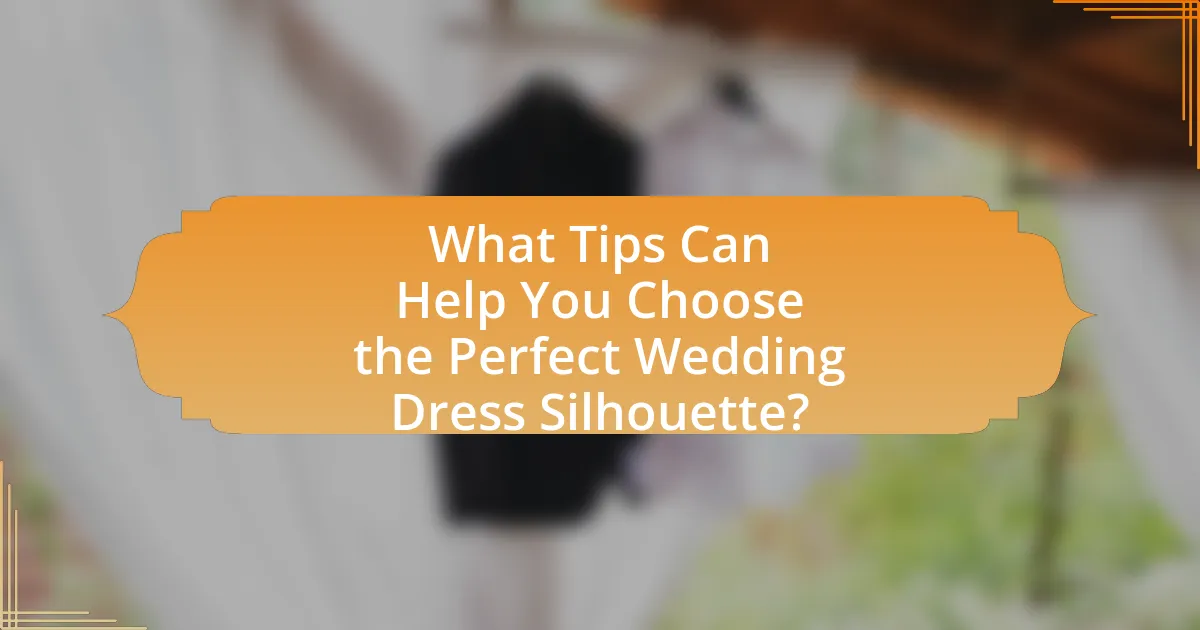
What Tips Can Help You Choose the Perfect Wedding Dress Silhouette?
To choose the perfect wedding dress silhouette, first identify your body type, as different silhouettes complement various shapes. For example, A-line dresses flatter pear-shaped bodies by accentuating the waist while skimming over the hips. Additionally, consider the venue and season; a fitted mermaid silhouette may be ideal for a formal indoor wedding, while a flowy sheath dress suits a beach setting. Lastly, prioritize comfort; ensure you can move freely in the dress, as this will enhance your confidence on your special day.
How can you effectively communicate your preferences to a bridal consultant?
To effectively communicate your preferences to a bridal consultant, clearly articulate your vision, including specific styles, fabrics, and silhouettes that resonate with you. Providing visual aids, such as photos or mood boards, can enhance understanding and ensure alignment with your desired aesthetic. Additionally, discussing your body type and how you wish to highlight or downplay certain features allows the consultant to recommend silhouettes that complement your shape. Research indicates that clear communication improves satisfaction in bridal consultations, as it enables consultants to tailor their suggestions to meet individual needs.
What questions should you ask during your bridal appointment?
During your bridal appointment, you should ask questions that clarify your options and ensure the dress complements your body type. Key questions include: “What silhouettes work best for my body shape?” This question helps you understand which styles will enhance your figure. Additionally, inquire about “What fabrics are most flattering for my body type?” Understanding fabric choices can significantly affect the overall look and comfort of the dress. You should also ask, “Can you show me examples of dresses that suit my body type?” This request allows the consultant to provide tailored recommendations based on their expertise. Lastly, ask about “What alterations can be made to customize the fit?” Knowing the alteration options ensures that the dress can be adjusted to fit you perfectly. These questions are essential for making an informed decision about your wedding dress.
How can you prepare for your dress fitting to ensure the best outcome?
To prepare for your dress fitting and ensure the best outcome, wear the undergarments you plan to use on your wedding day, as they significantly affect the fit and appearance of the dress. Additionally, bring any accessories you intend to wear, such as shoes or jewelry, to visualize the complete look. It is also beneficial to have a clear idea of your preferred styles and silhouettes, as this will help the fitter understand your vision and make appropriate recommendations. Lastly, arrive well-hydrated and avoid heavy meals before the fitting to maintain comfort and ease of movement, which is crucial for accurate adjustments.
What common mistakes should you avoid when selecting a wedding dress silhouette?
When selecting a wedding dress silhouette, common mistakes to avoid include ignoring body shape, neglecting comfort, and failing to consider the venue. Ignoring body shape can lead to choosing a silhouette that does not flatter the figure, such as selecting a mermaid style for a pear-shaped body, which can emphasize unwanted areas. Neglecting comfort may result in a dress that looks beautiful but is difficult to move in, impacting enjoyment on the wedding day. Additionally, failing to consider the venue can lead to mismatched styles; for example, a ball gown may be impractical for a beach wedding. These mistakes can significantly affect the overall experience and appearance on the wedding day.
How can overlooking your body type lead to dissatisfaction?
Overlooking your body type can lead to dissatisfaction by resulting in a poor fit and unflattering appearance of clothing, particularly wedding dresses. When individuals choose silhouettes that do not complement their unique shapes, they may feel uncomfortable and less confident, which can detract from their overall experience. Studies show that wearing clothing that aligns with one’s body type enhances self-esteem and body image, as evidenced by research published in the Journal of Fashion Marketing and Management, which highlights the psychological impact of clothing fit on individual satisfaction. Therefore, selecting a wedding dress silhouette that matches one’s body type is crucial for achieving both comfort and confidence on a significant day.
What are the pitfalls of following trends without considering personal fit?
Following trends without considering personal fit can lead to poor choices that do not enhance an individual’s unique body type. This often results in discomfort, dissatisfaction, and a lack of confidence on a significant occasion like a wedding. For instance, a trend may favor a specific silhouette that does not complement a person’s shape, leading to an unflattering appearance. Research indicates that 70% of brides regret their dress choice when they prioritize trends over personal style and fit, highlighting the importance of aligning choices with individual characteristics.
What final considerations should you keep in mind for your wedding dress silhouette?
When selecting a wedding dress silhouette, consider your body type, comfort, and the overall theme of your wedding. Understanding your body type helps in choosing a silhouette that enhances your best features; for example, an A-line dress flatters most figures, while a mermaid silhouette accentuates curves. Comfort is crucial, as you will be wearing the dress for an extended period; ensure that the silhouette allows for ease of movement. Additionally, the wedding theme influences the silhouette choice; a formal event may call for a ball gown, while a beach wedding might suit a more relaxed style. These considerations ensure that the chosen silhouette aligns with personal style and the event’s atmosphere.
How does comfort play a role in your choice of silhouette?
Comfort significantly influences the choice of silhouette in wedding dress selection. A comfortable silhouette allows for ease of movement and enhances the overall experience during the wedding day, which can last several hours. For instance, A-line and empire waist silhouettes are often preferred for their forgiving fit and ability to accommodate various body types while providing comfort. Studies indicate that comfort in clothing can positively affect mood and confidence, which is crucial on a significant day like a wedding. Therefore, prioritizing comfort in silhouette choice ensures that the bride feels at ease and confident throughout the event.
What should you consider regarding the wedding venue and dress silhouette?
When considering the wedding venue and dress silhouette, it is essential to ensure that the dress complements the venue’s style and atmosphere. For instance, a formal ballroom setting typically pairs well with elegant silhouettes like A-line or ball gown, while a beach venue may suit more relaxed styles such as sheath or fit-and-flare. The venue’s size also influences the dress choice; a spacious venue allows for more dramatic silhouettes, whereas a smaller venue may require simpler designs. Additionally, the season and weather conditions at the venue should guide fabric choices and dress length, ensuring comfort and appropriateness for the setting.
